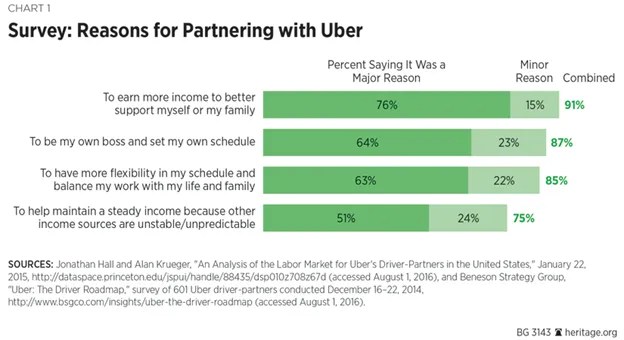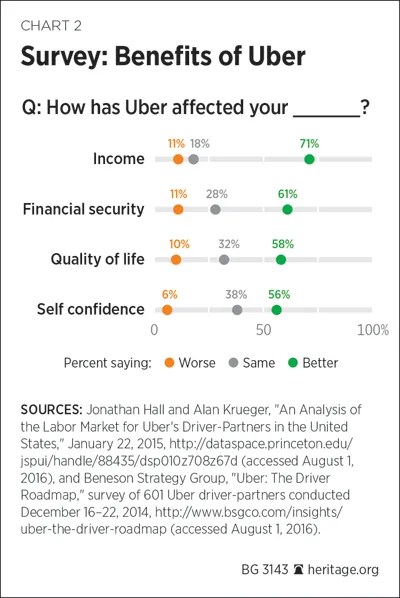
The gig economy remains fairly small — for now. Both RAND and JPMorgan Chase find that only about 0.5 percent of Americans earn labor income through gig platforms. However, this form of work is growing quickly. The JPMorgan analysts also reported that the number of Americans working in the gig economy grew by more than a factor of 50 between 2012 and 2015. The most prominent gig economy company — Uber — has quadrupled in size in less than two years. Uber grew from 160,000 active driver-partners in December 2014 to over 680,000 in September 2016.
The rise of the gig economy is good news for workers. Traditional jobs with fixed schedules work for many Americans — but not for everyone. The gig economy allows individuals who need flexibility to work on their own terms.
Some Workers Highly Value Flexible Schedules
Uber has attracted many drivers who place a high value on control of their time. Alan Krueger, the former chair of President Obama’s Council of Economic Advisors, and Jonathan Hall, the head economist and policy researcher at Uber, commissioned a survey of Uber’s driver-partners and asked why they drove for the company. Unsurprisingly, 91 percent said they did so to make more money.
But the next most common responses both dealt with flexibility; 87 percent of drivers said they worked with Uber “to be my own boss and set my own schedule.” Fully 85 percent said they did so “to have more flexibility in my schedule and balance my work with my life and family.”

Krueger and Hall found that Uber drivers value this flexibility for many reasons. Most have another job and drive with Uber to supplement their regular incomes. Some are students. A small number are stay-at-home parents. Ridesharing allows them to schedule work around their regular obligations. Often this involves a small number of part-time hours. Over half (51 percent) of Uber’s driver-partners work between 1 hour and 15 hours a week.
Uber allows these individuals to schedule work around their other commitments. If the gig economy did not exist, many gig workers could not hold a standard part-time job. Their employer’s schedule might conflict with their obligations to their family, or school, or main job. The gig economy lets Americans who need flexibility work on their own terms.
This explains why most gig workers do not want regular full-time jobs. Krueger and Hall’s survey also asked: “If both were available to you, at this point in your life, would you rather have a steady 9-to-5 job with some benefits and a set salary or a job where you choose your own schedule and be your own boss?” Almost three-quarters (73 percent) of Uber drivers preferred being their own boss. Similarly, Uber’s driver-partners appear quite happy with their work. Large majorities say that working with Uber has increased their incomes, their financial security, and their quality of life.

Krueger and Hall’s survey questioned only drivers for Uber, the largest of the gig-economy companies. The factors motivating its driver-partners probably apply to other gig-economy firms. Most Americans are satisfied with traditional 9-to-5 jobs; a minority of workers highly value flexibility or want to supplement their main earnings. These individuals seek out “gig” work.
Improved Working Conditions
Some workers in the gig economy do work full-time hours, including about one-fifth of Uber drivers. For many of these full-time workers the flexibility of the gig economy has improved their working conditions — especially in the taxi industry. Rideshare drivers appear to earn somewhat higher hourly wages than taxi drivers. They also avoid a system that pressures drivers to work long shifts.
Many cities (like New York) require government-issued medallions in order to operate a taxi. Investors typically buy these medallions and lease them to taxi drivers. Consequently, most taxi drivers start their shifts owing money. This pressures them to work long hours to recoup fixed lease costs. The medallion system explains why over a third of taxi drivers work more than 50 hours a week.
By contrast, ridesharing companies charge drivers a percentage of the fare on rides. The drivers never start out owing money. If they work fewer hours, they pay less, and vice versa. This gives Uber and Lyft drivers much more flexibility to work when they choose.
Most workers prefer higher wages and more flexible schedules. Krueger and Hall’s survey asked Uber drivers who previously drove taxis how partnering with Uber had affected them financially. Almost three-fifths (59 percent) said it had increased their incomes, only 17 percent said their incomes had decreased. Seventy-three percent of the former cabbies also said they now have more control over their schedules.
These survey answers are consistent with the actual behavior of taxi drivers: Many have switched to ridesharing. As one New York City taxi dispatcher told reporters, “Everyone is going to Uber, where they don’t have to pay a lease, and they don’t have to deal with a dispatch.”
Many workers prefer working in the gig economy; this explains (in part) why it has grown so quickly. Regulations that restrict the gig economy would leave many workers worse off.
This is being published as part of Evolution of Work. The views of the author are his own and are offered by the New York Fed to contribute to discussions on this topic.
This article was originally published by the New York Fed on Medium.
The views expressed in this article are those of the contributing authors and do not necessarily reflect the position of the New York Fed or the Federal Reserve System.










